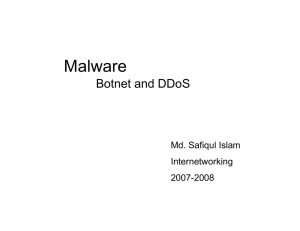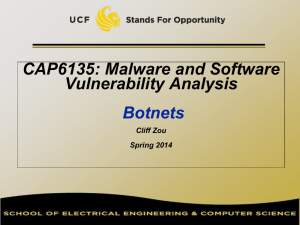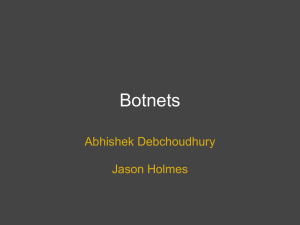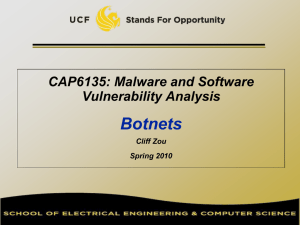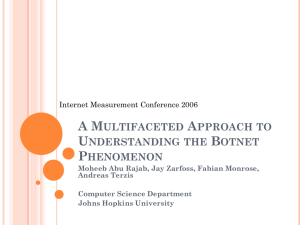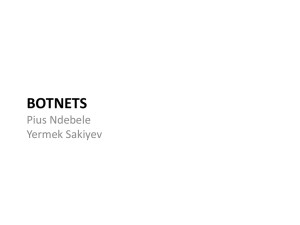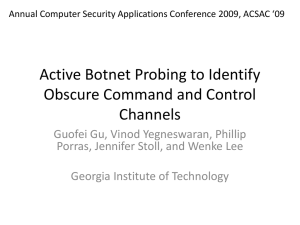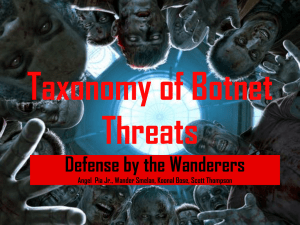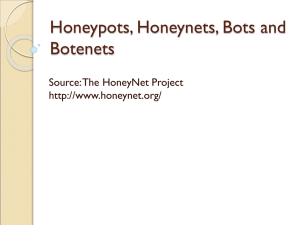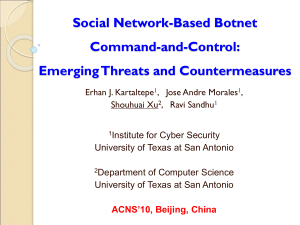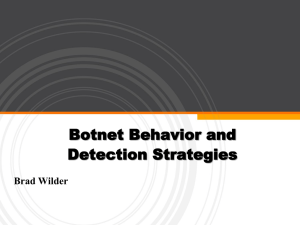Defending: Taxonomy of Botnet Threats
advertisement
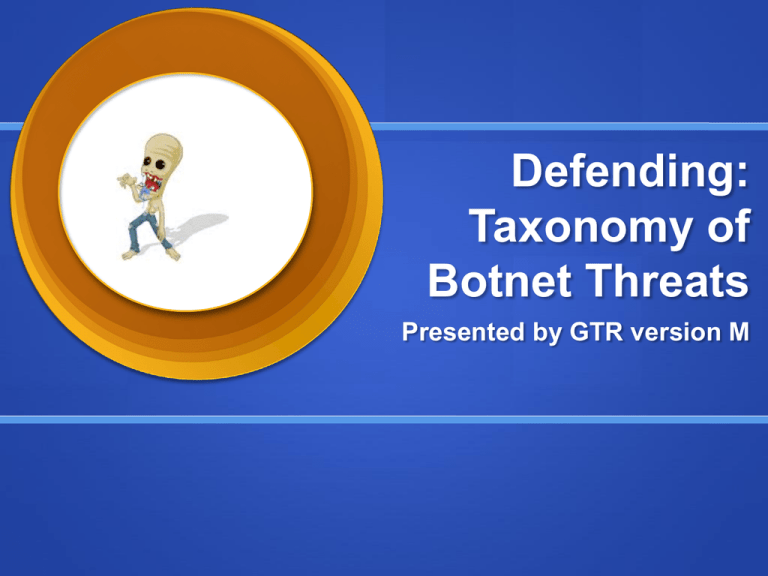
Defending: Taxonomy of Botnet Threats Presented by GTR version M Taxonomy of Botnet Threats Overview & Background Taxonomy Attacking Behavior Command and Control (C&C) Rallying Mechanisms Communication Protocols Evasion Techniques Other Observable Activities Overview and Background World of Botnets What is a Botnet? What is a Bot? What is a Botmaster? How they control others? Foundations of Botnets How they started Who controls them How they infiltrate Current status of bots Taxonomy Characteristics of botnets Techniques of detection Category of taxonomy Attacking Behavior Infecting new hosts Stealing sensitive information Phishing and spam proxy DDoS (Distributed Denial of Service) Attack Command and Control (C&C) Three Models: Centralized C&C Model P2P-Based C&C Model Random C&C Model Centralized Model Pros: password protected to prevent eavesdropping simple to implement or customize easy for Botmaster to control Cons: C&C server is crucial for most conversations to happen weakest link; destroy server, destroy Botnet P2P Model Pros: harder to discover and destroy does not depend on few selected servers destroying single or few bots won't lead to destruction of an entire bonnet harder to defend against more robust than centralized Cons: small user groups, 10-50 users no guarantee of msg delivery and propagation latency harder to coordinate than centralized used to attack a small number of target host P2P Model Pros: harder to discover and destroy does not depend on few selected servers destroying single or few bots won't lead to destruction of an entire bonnet harder to defend against more robust than centralized Cons: small user groups, 10-50 users no guarantee of msg delivery and propagation latency harder to coordinate than centralized used to attack a small number of target host Random Model Pros: easy to implement and highly resilient to discovery and destruction bots won't actively contact other bots or botmasters bots would listen to incoming connections from its botmaster botmaster scans internet to discover its bots, then issue command to bot Cons: has scalability problem and difficult to be used for large scale, coordinated attacks Rallying Mechanisms Hard coded IP address Dynamic DNS Domain name Distributed DNS Service Hard coded IP Address IP address of C&C server is hard coded into the binary at the bot. C&C server can be easily detected and communication channel can be easily blocked. Not much used by current bots. Dynamic DNS Domain name Hard-coded domains assigned by dynamical DNS providers. If connection fails, the bot performs DNS queries to obtain the new C&C address for redirection. Detection harder when botmaster randomly changes the location. Distributed DNS Service Botnets run own DNS service out of reach of authorities. Bots use the DNS addresses to resolve the C&C servers. Use high port numbers to avoid detection by security devices and gateways. Hardest to detect & destroy. Communication Protocols Determine the origins of a botnet attack and the software being used. Allow researchers to decode conversations happening between the bots and the masters . There are two main Communication Protocols used for bot attacks: IRC HTTP IRC Protocol Mainly designed for group communication but can also handle private messages between two people. Inbound vs Outbound IRC traffic. Firewalls can be configured to block IRC traffic in corporate environments. IRC Protocol It suffers from a major drawback of using a Centralized Server. HTTP Protocol Strength: HTTP makes botnets harder to detect. Firewalls block IRC ports but not HTTP. Weakness: It can still can be detected using appropriate filters. Bot HTTP Traffic is different from normal traffic. Evasion and Detection Evasion and Detection Understand the problem: There is no clear distinction between viruses, worms, and bots Worms are viruses since they compromise hosts Early viruses propagated via file replication Bots are advanced worms/viruses since they propagate via hosts Evasion Techniques From Signature-based Detection Executable Packers - unpacking code, then transferring control to code Rootkits - apps that gain access to a PC, then stay hidden until needed Protocol evasion techniques such as exploiting differences in how an OS interacts with a protocol such as TCP Evasion Techniques From Anomaly-based detection systems Modified communication protocols: IRC, HTTP, VoIP Utilize encryption to hide communications Alternative channels: TCP, ICMP or IPv6 tunneling SKYPE and/or IM are a matter of time Effective Detection Alternative Combination of Techniques: Detect connections to C&C centers Monitor for Communication Traffic Monitor for Anomalous Behavior Combating Botnets focusing on Detectable Behavior Global Correlation Behavior Network-based Behavior Host-Based Behavior Global Correlated Behavior Commonalities across different Botnet implementations: Detect DNS changes for C&C host Large numbers of DNS queries BONUS: Operation Bot Roast I - The FBI's program to go after botnet creators, because the problem has become an issue of national security. Network Behaviors Observable Communications: Monitor IRC & HTTP traffic to servers that don't require these protocols IRC traffic that is not “human readable” DNS queries (lookups for C&C controllers) Frequency changes in IP for DNS lookups Long idle periods followed by very rapid responses Very bursty traffic patterns Attack Traffic: Denial of Service: TCP SYN packets (invalid source) Internal system(s) sending phishing emails Host-based Behaviors Detectable activity on an infected host: Disabled Anti-virus Large numbers of updates to system registry Specific system/library call sequences Conclusion Stopping botnets is not easy. Their decentralized nature, their use of unsuspecting systems makes it difficult to counter. Instead, defending requires some unearthing to find the source of the problem. That digging becomes admittedly harder and harder as botmasters become smarter and wilier. FBI Warning! THANK YOU
